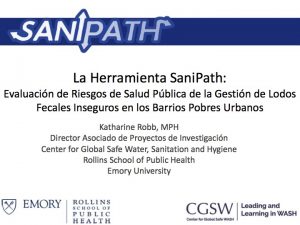THREE Great Features of the Sanipath Tool
The SaniPath team has created an exposure assessment tool for low-resource, urban areas with poor sanitation. Key features of the tool include its accessibility, its easy to understand results, and its potential to influence policy.
1. The SaniPath Tool is easy to use and understand
The SaniPath Tool was designed to be used independently by a variety of organizations interested in improving urban sanitation. A detailed user guide for data collection and laboratory work, automated analyses, and output that can be understood by anyone with a basic scientific background, make the tool easy to use and understand. Minimum requirements for use of the tool include:
- A funding source (ex: local government or international organization)
- A lab with the ability to detect E. coli and technicians to carry out the procedures in a sterile environment
- A team with experience conducting surveys
- A local group to distribute results to government and policy makers



